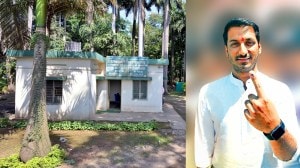Alone, Thane’s tribals fight starvation
As two severely malnourished children recover at J.J. Hospital, in their village near Mumbai, the situation is worsening. Talavali village i...

As two severely malnourished children recover at J.J. Hospital, in their village near Mumbai, the situation is worsening. Talavali village in Bhiwandi taluka, 45 km from Mumbai, has six malnourished children — a majority suffering from Grade-III malnutrition.
Like four-year-old Ganga Hileem. With a bloated abdomen, severe cough and a lack of appetite, Hileem is exhibiting all the signs of Grade III malnutrition, but his parents haven’t taken him to a doctor. ‘‘Who will take care of the others when we are in the hospital?’’ asks Mina, a 35-year-old mother of five.
Husband Suresh, an alcoholic, works at the rice fields to earn a measly Rs 30 a day — a major chunk of which goes towards the daily quota of liquor.
The deputy sarpanch of the village, Kaifi Patel, is not worried. ‘‘Everybody is fine here,’’ he insists.
Official statistics at the Women and Child Welfare Department, Thane Zilla Parishad, say otherwise. Until December 2004, 1,510 cases of malnourished children (Grade III and IV) were detected in Thane district’s 13 talukas, including Bhiwandi. In January 2005, the number shot up to 2,495.
|
|
|
The Thane report has reached me, but I’ve been on tour for the past three days, so I can’t say much. It’s a serious issue that must be looked into
— Harshvardhan Patil, Women and Child Development Minister |
|
|
It’s a similar story in Bhiwandi. The figures for malnourished children have gone up from 28 in December 2004 to 121 in January this year. Last year, 149 children below 6 years died — due to starvation and other illnesses — in the 200 villages of Bhiwandi taluka.
At a time when the Bombay HC has directed the state to submit a report on steps taken to tackle Maharashtra’s malnutrition problem, the figures are shocking. But the administration believes the cases are ‘‘being tackled properly’’.
‘‘Now the gradation has become more accurate, even borderline cases have been included,’’ says Sudhakar Shinde, deputy CEO, Integrated Child Development Scheme (ICDS), explaining the rise.
Shinde is one of the officials responsible for ensuring the ICDS — the state government scheme under which children (below six years) in tribal areas should be fed free khichdi and supplementary vitamins — is implemented in Thane district.
|
|
|
I’ve held a meeting with officers in Thane and appropriate steps are being taken
— Dr Vimal Mundada, Health Minister |
|
|
But adivasi women in Talavali say they haven’t received either for the last two weeks. The village does not have an anganwadi, the local unit where children are fed the khichdi and vitamins.
But health officials are adamant they have done their bit. ‘‘We examined these children in January, they were fine,’’ says Bhiwandi taluka’s Child Development Project Officer Anamika Hingole. ‘‘Often, the mothers are responsible.’’
Outside the paediatric ward at J.J. Hospital, a sobbing Manda Pitamberi says she’s not to blame for her son Vijay’s condition — the five-year-old was admitted to the hospital with Grade IV malnutrition. ‘‘My husband spends his daily earnings on alcohol, so there’s no food for the children,’’ says the mother of four. ‘‘What is the government doing for us?’’



- 01
- 02
- 03
- 04
- 05




























